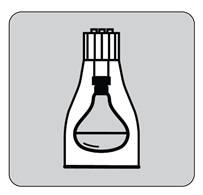
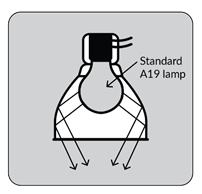

Luminaires and light sources emit light and illuminate spaces. The Energy Code include a system of classification to account for the power of luminaires and lighting systems and use the information for assessing compliance.
Below is the list of luminaire types described and classified in §130.0(c):
•Luminaires with line-voltage lamp holders
•Luminaires with ballasts
•Inseparable solid-state lighting (SSL) luminaires and SSL luminaires with remote drivers
•LED tape lighting and LED linear lighting
•Modular lighting systems
•Other lighting equipment
The wattage of all planned lighting systems, including permanent and portable lighting, shall be determined as follows.
The wattage of luminaires with line-voltage lamp holders not served by drivers, ballasts, or transformers shall be the maximum-rated wattage of the luminaire.
Figure 5-1: Examples of Luminaires With Line-Voltage Lamp Holders



Image Source: Energy Solutions
The wattage of luminaires with permanently installed or remotely installed ballasts shall be the operating input wattage of the rated lamp/ballast combination.
This wattage information can be found in the ballast manufacturer’s catalogs based on an independent testing lab report as specified in UL 1598.
The wattage of inseparable SSL luminaires and SSL luminaires with remote ballasts shall be the maximum-rated input wattage of the SSL luminaire.
Inseparable SSL luminaires are luminaires manufactured with solid-state lighting components that are not readily removed or replaced from the luminaires by the end users.
SSL luminaires shall be tested in accordance with UL 1598, 2108, or 8750, or IES LM-79.
Figure 5-2: Examples of SSL Luminaires: Recessed Downlight Luminaires
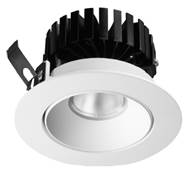

Image Source: Lutron Electronics Co., Inc.
LED tape lighting can be installed in varying lengths by installers on a project site as determined by the lighting design requirements. LED tape lighting is not like luminaires, which are manufactured in predetermined dimensions per customer order.
The wattage of LED tape lighting and LED linear lighting with LED tape lighting components shall be the sum of the installed length of the tape lighting times its rated linear power density in W/ft or the maximum-rated input wattage of the driver or power supply providing power to the lighting system.
Tape lighting shall be tested in accordance with UL 2108 or 8750, or IES LM-79.
Figure 5-3 Examples of LED Tape Lighting

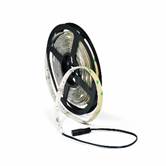
Source: NORA Lighting
Track-mounted and rail-mounted luminaires that allow the addition or relocation of luminaires without altering the wiring are examples of modular lighting systems. The wattage of these systems shall be determined as follows:
•The wattage shall be the greater of 30 watts per linear foot of track or plug-in busway or the rated wattage of all of the luminaires in the system (where the luminaire wattage is as specified by UL 1574, 1598, 2108, or 8750).
•For line-voltage track lighting and plug-in busway served by a track lighting current limiter, the wattage shall be the volt-ampere rating of the current limiter as specified by UL 1077.
•For line-voltage track lighting and plug-in busway served by a track lighting protection panel, the wattage shall be the sum of the ampere ratings of all the overcurrent protection devices times the branch circuit voltage for the track lighting protection panel.
•For other modular systems with power supplied by a driver, power supply, or transformer, including low-voltage lighting systems, the wattage shall be the maximum rated input wattage of the driver, power supply, or transformer as specified by UL 2108 or 8750.
•For power-over-Ethernet lighting systems, the wattage shall be the total power rating of the system less any installed nonlighting devices.
Figure 5-4 A Track Lighting System (top image); A Track Lighting Installation (bottom image)
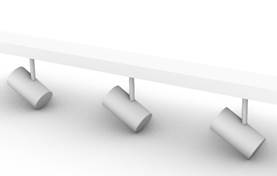
Image Source: California Energy Commission
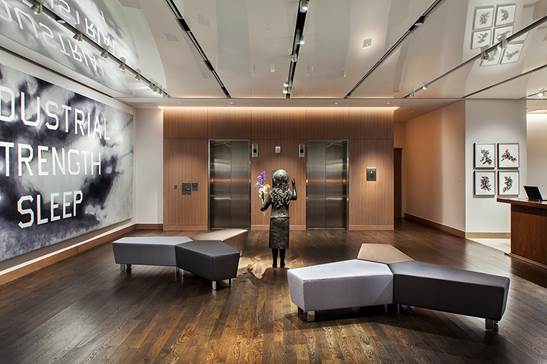
Image Source: Acuity Brands Lighting, Inc.
For lighting equipment not addressed above, the wattage of the lighting equipment shall be the maximum-rated wattage of the lighting equipment or the operating input wattage of the system, based on independent test lab reports as specified by UL-1547, 1598, 2108, or 8750, or IES LM-79.
Example 5-1 Power-Over-Ethernet Lighting
Question
What is a power-over-Ethernet (PoE) lighting system?
Answer
A PoE lighting system provides low-voltage direct current and communication over Ethernet cabling. By contrast, most conventional lighting systems use alternating current to power luminaires.
A PoE lighting system usually contains three main components — a powered device (PD), Ethernet cabling, and power sourcing equipment (PSE) such as Ethernet switches. PSE is a general term used for a PoE power supply.
PSEs supply power via Ethernet cabling to PDs, such as PoE luminaires.
Example 5-2 PoE Lighting
Question
What is the wattage of a PoE lighting system that contains a PoE switch, nine PoE luminaires, occupancy sensors, one daylight sensor, and wall switch stations?
Answer
One way to determine the answer is to account for the wattage of all the luminaires in the lighting system as the wattage of the PoE lighting system. Since there are nine PoE luminaires plus other nonlighting loads (sensors and switches), the wattage of the PoE lighting system is the sum of the wattage of all PoE luminaires, excluding the sensors and control switches.
Another way is to account for the total power rating of the system less any nonlighting devices such as occupancy sensors, sensing devices, and switch controls.
The following is a selection of lighting terms defined in §100.1 and included here to help readers understand the requirements.
General lighting (also known as ambient lighting) is electric lighting that provides a uniform level of illumination throughout an area exclusive of any provision for special visual tasks or decorative effect, or exclusive of daylighting.
Typical luminaires used for general lighting are troffers (prismatic, parabolic, or indirect diffusers), pendants (direct, indirect, or direct/indirect), high bay, low bay, and “aisle-lighter” fixtures. General lighting does not include display lighting (typically using directional MR, PAR, flood, spot, or wall washers) or decorative lighting (such as drum fixtures, chandeliers, or projection lighting.)
Section 100.1 also defines decorative, display, task, and special effects lighting as follows:
•Decorative lighting or luminaires are installed only for aesthetic purposes that do not serve as display lighting or general lighting. Decorative luminaires are chandeliers, sconces, lanterns, cove lighting, neon or cold cathode, theatrical projectors, moving lights, and light color panels, not providing general lighting or task lighting.
•Display lighting is supplementary lighting that provides a higher level of illuminance to a specific area than the level of surrounding ambient illuminance required to highlight features, such as merchandise, sculpture, or artwork.
•Task lighting is lighting directed to a specific surface or area providing illumination for visual tasks. Task lighting is not general lighting.
•Special effects lighting is lighting installed to give off luminance instead of providing illuminance, which does not serve as general, task, or display lighting.
Special effects lighting is different from decorative lighting. The only place special effects lighting is used is for the Decorative/Special Effects Lighting additional power allowance in the tailored method for lighting power compliance in Table 140.6-D where both terms are combined.
Both the Area Category Method (Table 140.6-C|tag=TABLE_140_6_C) and the Tailored Method (Table 140.6-D) provide additional lighting power allowances for lighting that is not considered general lighting; however, to claim these allowances, the nongeneral lighting systems must be separately switched.
For layered lighting designs with multiple luminaire types, compliance documentation will require allocating some or all nongeneral lighting power to the additional lighting power allowances and the rest of the lighting wattage to the general lighting power allowance. Only the general lighting power allowance is able to be shared across different spaces.
When there is only one lighting system type in a space, such as is the case when a monolithic design approach is taken, that system type will be treated as general lighting. Thus, light fixtures that might ordinarily be considered decorative or display luminaires are considered general lighting luminaires if they are the only system type in a given enclosed space.
Example 5-3 LED Tape Lighting
LED tape lighting may be classified as Decorative Lighting, Task Lighting, or General Lighting, based on how it is used. Figure 5-5 shows two applications of LED tape lighting.
The image G3-A on the left shows LED tape lighting that is installed in a channel mounted to the underside of a shelf or cabinet or installed directly with adhesive material. This use would be classified as display or task lighting. Such applications are not considered General Lighting.
The image G3-B on the right shows an architectural cove with tape lighting installed in a channel mounted within the cove or installed directly with adhesive material. This use may be classified as Decorative or Display Lighting or considered General Lighting, based on whether the illumination emanating from the cove is the only source of uniform lighting in the space.
Figure 5-5 Examples of LED Tape Lighting: In Use as Undershelf Lighting (left image); In Use as Cove Lighting (right image)
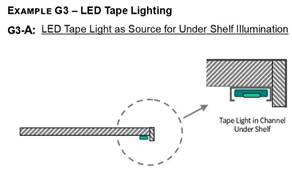
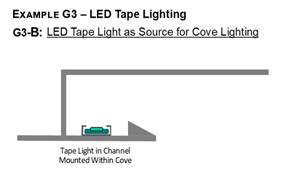
Image Source: Bernie Bauer
Example 5-4: Cove Lighting
Room A & Room B have two lighting systems: The first system consists of linear luminaires mounted in a cove to provide up-lighting bouncing off the ceiling and providing general illumination. The other system is a series of downlights providing task illumination over an alcove in the room. Cove lighting may be classified as decorative or display lighting when there are other luminaires providing general illumination. However, the cove lighting in this example also provides general illumination. Therefore, the cove lighting luminaire power is applied to the allowed general lighting LPD shown in Table 140.6-C|tag=TABLE_140_6_C Area Category Method or Table 140.6-D Tailored Method instead of as a decorative or display allowance from Table 140.6-C|tag=TABLE_140_6_C or Table 140.6-D. The lighting power of the downlights providing task illumination are assigned to Additional Lighting Power in Table 140.6-C|tag=TABLE_140_6_C or Allowed Task Lighting Power in Table 140.6-D, provided they are on a separate circuit. If they are on the same circuit as the cove lights, they must also be included in the base lighting allowance.
Room C has three lighting systems:
1) Asymmetric distribution luminaires mounted in a cove to provide up-lighting bouncing off the ceiling for visual enhancement.
2) A grid of flood downlights designed to provide general illumination.
3) A series of downlights providing task illumination over two alcoves in the room. Cove lighting in this scenario may be classified as decorative or display lighting and can use the decorative/display allowances shown in Table 140.6-C|tag=TABLE_140_6_C or the decorative/special effects allowance in Table 140.6-D, provided one is available for the space type in which the cove is located, and the cove is separately circuited from the downlights. The flood downlights are designed to provide general/ambient illumination; therefore, the general lighting LPD allowances in Table 140.6-C|tag=TABLE_140_6_C or 140.6-D apply. As with the cove lights, the downlights providing task illumination can use the appropriate additional allowances in Table 140.6-C|tag=TABLE_140_6_C or 140.6-D, provided one is available and they are separately circuited.
Figure 5-6 Examples of Cove Lighting: Asymmetric Distribution Luminaires in Cove (Room C); Linear Luminaires in Cove (Rooms A and B)
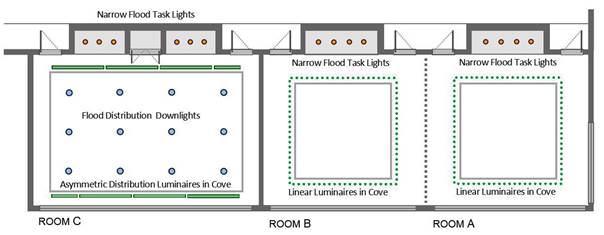
Image Source: Bernie Bauer